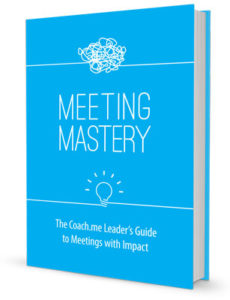 Life is too short to suffer through bad meetings.
Life is too short to suffer through bad meetings.
More times than I like to count, individuals contact me about meeting difficulties that they’ve been grappling with, sometimes for years.
Almost always their meeting problems stem from bad meeting habits, based on these three root causes:
- No standard processes or poor processes that are mostly ignored.
- Dysfunctional behaviors of meeting participants that have festered over time.
- Assumptions that new team members will figure out on their own how the meetings run. (This is even more problematic when meeting processes and team relationships are broken.)
Bad meetings don’t solve themselves on their own. They’ll continue to suck up valuable time, energy and resources, unless you intervene and take action.
In situations like this, it’s best to start building new good meeting habits, rather than try to break the old, based on what social scientists and neuroscientists have learned about habits. In a nutshell, because of the brain’s plasticity, it’s easier for the brain to create new wiring rather than rewire the old.
So if you’re dealing with painful bad meetings, where do you start?
One helpful resource is the new book Meeting Mastery: The Coach.me Leader’s Guide to Meetings with Impact and the companion online program, Meeting Mastery Certification.
Some background first. If you’re not familiar with Coach.me, its mission is to make coaching “the dominant form of self-improvement in every field from business to education to fitness.” Coaches provide targeted, structured support by phone, text and email.
Founder/CEO Tony Stubblebine is a former programmer and engineering manager who built Coach.me out of Lift, an online habit tracker app. (I used Lift successfully for several years. See Making SCARF a daily habit. And in the interest of full disclosure, I’m affiliated with Coach.me.)
The Meeting Mastery book and online course benefit from the technology roots of Coach.me and Lift. Technology is all about systems thinking and design, including processes.
This orientation works well for improving your meetings, especially for building good, consistent and repeatable meeting habits.
The technology roots help in another way too. Many in the technology industry pay attention to what others do, and incorporate those learnings in their products, services and businesses. That’s happened here as Meeting Mastery is built off of meeting practices that many cutting-edge companies like IDEO, Apple and Amazon use.
After a short introduction, the Meeting Mastery book starts with a short useful checklist for running meetings. These tips are for working meetings—getting people together to collaborate on creating, planning, implementing and anything but presenting static information to one another.
The checklist and the easy-to-use tools that follow help you with all three critical meeting stages: preparing, conducting and debriefing.
In my experience, many leaders and participants focus primarily on the meeting itself. They short change both the prep time and the follow-up.
Yet, if you carefully prepare, including developing an agenda, and then vigilantly track action items holding people accountable for their commitments, you exponentially improve the quality of your meetings and your work.
Take the meeting preparation. Meeting Mastery features the GAP methodology, which comes from Tim Roberts, an executive at Fitbit. GAP stands for goal, agenda, and preparation.
GAP is simple and powerful. Meeting leaders set the meeting goal and create the agenda, which they share in advance with the meeting participants. The leaders also let the meeting participants know ahead of time what they need to do before the meeting. Everyone shares some responsibilities.
And by the time you meet, you’re well on your way to getting the right things done.
If you’re willing to try — and continuing practicing — this book’s many other useful tools, it’s easy to build good meeting habits.
These other tools encourage action, accountability and recognition for jobs well done, in and out of meetings.
By the way, recognition is a great addition to meetings because praise helps rewire the brain to repeat the action. (For more about this, see Making celebrations a habit.)
Considering the number of hours most of us spend in meetings and the amount of time we complain about bad meetings, it’s time to do something about it.
Are you ready to start building new good meeting habits?

0 Comments